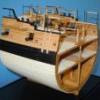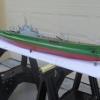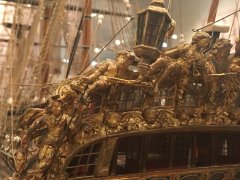MORE HANDBOOKS ARE ON THEIR WAY! We will let you know when they get here.
×
-
Posts
2,437 -
Joined
-
Last visited
Reputation Activity
-
 dvm27 got a reaction from FriedClams in HMS ROYAL KATHERINE 1664 by Doris - 1/55 - CARD
dvm27 got a reaction from FriedClams in HMS ROYAL KATHERINE 1664 by Doris - 1/55 - CARD
Seriously, Doris? Broad arrow and proof marks on your cannons? I've never seen them on a model before. I believe you just gave Mark S. a heart attack. Truly you are a wonder!
-
 dvm27 got a reaction from Piet in HMS ROYAL KATHERINE 1664 by Doris - 1/55 - CARD
dvm27 got a reaction from Piet in HMS ROYAL KATHERINE 1664 by Doris - 1/55 - CARD
Seriously, Doris? Broad arrow and proof marks on your cannons? I've never seen them on a model before. I believe you just gave Mark S. a heart attack. Truly you are a wonder!
-
 dvm27 got a reaction from davyboy in HMS ROYAL KATHERINE 1664 by Doris - 1/55 - CARD
dvm27 got a reaction from davyboy in HMS ROYAL KATHERINE 1664 by Doris - 1/55 - CARD
Seriously, Doris? Broad arrow and proof marks on your cannons? I've never seen them on a model before. I believe you just gave Mark S. a heart attack. Truly you are a wonder!
-
 dvm27 reacted to GAW in Falls of Clyde 1878 by GAW - FINISHED - scale 1:96 - iron 40-frame hull center cross-section
dvm27 reacted to GAW in Falls of Clyde 1878 by GAW - FINISHED - scale 1:96 - iron 40-frame hull center cross-section
Fig-156 - The complete assembly installed in the finished model - a very interesting exercise, I do enjoy scratch building and particularly the research to try and get things right. Everything is there for a reason, and in most cases it is possible to find out exactly what the reason is/was, and researching it these days with the history of the world on tap on the internet, at the press of a button, it can be as much fun as creating the item in the round - for me I like to know what I am recreating, where it came from and why.
-
 dvm27 reacted to druxey in General / organisation of wood
dvm27 reacted to druxey in General / organisation of wood
Just found this thread. The quantity and quality of carved work on the gondola is amazing. Congratulations, Merchen. Wunderbar!
Perhaps you would get more responses if you posted the pictures under the subject 'scratch built models' rather than 'organization of wood'.
-
 dvm27 reacted to SJSoane in Admiralty model query
dvm27 reacted to SJSoane in Admiralty model query
The best books, in my view, for understanding the entire scratch build process with every step spelled out, are 1) The Fully Framed Model, HMN Swan Class Sloops 1767-1780, vols. 1,2,4 by David Antscherl and vol. 3 by Greg Herbert, and 2) Ed Tosti's books, especially for the period of your intended subject, Frigates of the Royal Navy: The Naiad Frigate. These show how much there is to do, but break it down into manageable parts with lots of drawings and photos, and clear explanations. I have learned immensely from these fine craftsmen and authors.
Mark
-
 dvm27 reacted to Bob Cleek in Admiralty model query
dvm27 reacted to Bob Cleek in Admiralty model query
They aren't "bulkheads" or frames. They are station lines. The stations are depicted in a standard draft at each station line on the baseline. (The lines pictured were drawn for the purpose of modeling and have some modeling-specific information in them, however.) These station lines, together with the other lines in the draft, define the shape of the vessel. The table of offsets, correspondingly, defines the dimensions of the lines. While, in smaller craft particularly, frames may coincide with station lines, that is more a matter of coincidence than anything else. In a larger, heavier vessel, such as the one above, were every frame to be represented with a station line, the drawing would be so full of lines as to be unreadable and for the purposes of defining the shape of the hull, unnecessary.
Station lines have nothing to do with the construction details of the vessel. The construction of a vessel is addressed by the construction drawings, if there are any. (And in period vessels, there rarely are, as such details were left to be worked out by the master shipwright.) If you want to build a model using bulkheads, stations may be used to define your bulkheads. If you wish to build a model with frames the way the vessel was actually built, as with an Admiralty model, you will have to research the methods of construction at the time the vessel was built and apply that research to determine how the parts were fashioned to build it. The Admiralty had detailed rules for construction, sometimes called "scantlings," which you can look up in resource materials. These scantling rules dictate, based on the overall size of a vessel, the size of framing timbers and frame spacing, the thickness of planking, and on and on.
The task of translating "lines," as above, to patterns for the actual parts of a vessel is called "lofting," because it was usually done on a wooden floor in a loft at the shipyards. Using the scale lines drawings and the scantling rules, the loftsman draws all the parts of the vessel full-scale and "takes up" (transfers) these "loftings" to create full-sized patterns which are then used to define the shape of all the parts that go into the vessel. If one wishes to build a model of the vessel with the lines above, they will have to "loft" the construction drawings at the desired scale and work from those in constructing the model "Admiralty style" in the same way the full-sized vessel was built. (Which, without the actual prototype available, will always be an educated approximation, since the form of the parts was often dictated by the size and shape of the raw wood available to the builders at the time.)
A command of lofting is essential to using lines drawings to create scale models. With it, one has a huge selection of vessels from which they might select a subject to model. Without it, they are left to those relatively few subjects for which plans for modelers have been drawn up and offered for sale. (This is one reason why so many models of the same few ships keep getting built from commercially produced kits. Therein lies the distinction between "kit building" and "model making.") A good basic explanation of lofting is contained in Howard I. Chapelle's book, Boatbuilding. A far more comprehensive treatment of all aspects of lofting, including, for example, the methods for determining the degree of bevel on each frame of a hull, are contained in Alan Vaites' book, Lofting. (Both are readily available.)
The common use of lines drawings is relatively recent, coming into use sometime in the Seventeenth Century, IIRC. Like all drafting, naval architectural drafting is a "language" which must be learned. The Lords of the Admiralty and the other bureaucrats who decided which vessel would be built were often, like most laymen, completely incapable of "reading" a set of lines on a sheet of paper. This why the Admiralty models came into being... to provide a readily understandable three-dimensional representation of the vessel proposed to be built to people who were unable to translate a two-dimensional set of lines to three-dimensions in their heads.
-
 dvm27 got a reaction from EJ_L in HMS ROYAL KATHERINE 1664 by Doris - 1/55 - CARD
dvm27 got a reaction from EJ_L in HMS ROYAL KATHERINE 1664 by Doris - 1/55 - CARD
Seriously, Doris? Broad arrow and proof marks on your cannons? I've never seen them on a model before. I believe you just gave Mark S. a heart attack. Truly you are a wonder!
-
 dvm27 got a reaction from DORIS in HMS ROYAL KATHERINE 1664 by Doris - 1/55 - CARD
dvm27 got a reaction from DORIS in HMS ROYAL KATHERINE 1664 by Doris - 1/55 - CARD
Seriously, Doris? Broad arrow and proof marks on your cannons? I've never seen them on a model before. I believe you just gave Mark S. a heart attack. Truly you are a wonder!
-
 dvm27 got a reaction from michael mott in HMS ROYAL KATHERINE 1664 by Doris - 1/55 - CARD
dvm27 got a reaction from michael mott in HMS ROYAL KATHERINE 1664 by Doris - 1/55 - CARD
Seriously, Doris? Broad arrow and proof marks on your cannons? I've never seen them on a model before. I believe you just gave Mark S. a heart attack. Truly you are a wonder!
-
 dvm27 got a reaction from druxey in HMS ROYAL KATHERINE 1664 by Doris - 1/55 - CARD
dvm27 got a reaction from druxey in HMS ROYAL KATHERINE 1664 by Doris - 1/55 - CARD
Seriously, Doris? Broad arrow and proof marks on your cannons? I've never seen them on a model before. I believe you just gave Mark S. a heart attack. Truly you are a wonder!
-
 dvm27 reacted to Hubac's Historian in HMS ROYAL KATHERINE 1664 by Doris - 1/55 - CARD
dvm27 reacted to Hubac's Historian in HMS ROYAL KATHERINE 1664 by Doris - 1/55 - CARD
No kidding!! I really can’t even wrap my head around that last bit - the proof marks. Next, she’ll make a 1:1 card scale model of an atom.
-
 dvm27 got a reaction from RichardG in HMS ROYAL KATHERINE 1664 by Doris - 1/55 - CARD
dvm27 got a reaction from RichardG in HMS ROYAL KATHERINE 1664 by Doris - 1/55 - CARD
Seriously, Doris? Broad arrow and proof marks on your cannons? I've never seen them on a model before. I believe you just gave Mark S. a heart attack. Truly you are a wonder!
-
 dvm27 got a reaction from Canute in HMS Bellerophon 1786 by AON – scale 1:64 – 74-gun 3rd Rate Man of War - Arrogant-Class
dvm27 got a reaction from Canute in HMS Bellerophon 1786 by AON – scale 1:64 – 74-gun 3rd Rate Man of War - Arrogant-Class
We (Admiralty Models) will conduct a workshop on carving sometime this year (mid-year we think). We are open to conducting it on either side of the border but past logistics seem to indicate that the easiest venue is in Baltimore. Our expenses are the least there, hence we can keep the workshop fee at a reasonable level. Further details will be posted on MSW and our website www.admiraltymodels.com, soon.
-
 dvm27 got a reaction from daHeld73 in HMS Bellona 1760 by SJSoane - Scale 1:64 - English 74-gun - as designed
dvm27 got a reaction from daHeld73 in HMS Bellona 1760 by SJSoane - Scale 1:64 - English 74-gun - as designed
Don’t forget that the three most impressive objects on Longridge’s Victory, the stern lanterns, were made by another craftsmen. Besides, if you’re truly emulating a Navy Board Model, most of these specialty items were farmed out to jewelers and other specialists so you’d be in good company.
-
 dvm27 got a reaction from KentM in HMS Thorn by Kevin Kenny - 1:48 scale - Swan-class - David Antscherl practium
dvm27 got a reaction from KentM in HMS Thorn by Kevin Kenny - 1:48 scale - Swan-class - David Antscherl practium
Very nice job, Kevin. Rest assured I didn’t get the block correct on my first try either!
-
 dvm27 reacted to Forlani daniel in Chebece 1750 by Forlani daniel - FINISHED - 1:48
dvm27 reacted to Forlani daniel in Chebece 1750 by Forlani daniel - FINISHED - 1:48
Good morning and thank you all.
Un Saluto.
-
 dvm27 reacted to druxey in La Legere 1682 by woodeater - FINISHED - scale 1:32 - French frigate
dvm27 reacted to druxey in La Legere 1682 by woodeater - FINISHED - scale 1:32 - French frigate
Nice work on those lodging knees that cross each other!
-

-
 dvm27 reacted to Valeriy V in Varyag 1901 by Valeriy V - FINISHED - scale 1:75 - Russian Cruiser
dvm27 reacted to Valeriy V in Varyag 1901 by Valeriy V - FINISHED - scale 1:75 - Russian Cruiser
Anchor hawse-hole and stiffener.
-
 dvm27 got a reaction from mtaylor in HMS Bellona 1760 by SJSoane - Scale 1:64 - English 74-gun - as designed
dvm27 got a reaction from mtaylor in HMS Bellona 1760 by SJSoane - Scale 1:64 - English 74-gun - as designed
Don’t forget that the three most impressive objects on Longridge’s Victory, the stern lanterns, were made by another craftsmen. Besides, if you’re truly emulating a Navy Board Model, most of these specialty items were farmed out to jewelers and other specialists so you’d be in good company.
-
 dvm27 got a reaction from druxey in HMS Bellona 1760 by SJSoane - Scale 1:64 - English 74-gun - as designed
dvm27 got a reaction from druxey in HMS Bellona 1760 by SJSoane - Scale 1:64 - English 74-gun - as designed
Don’t forget that the three most impressive objects on Longridge’s Victory, the stern lanterns, were made by another craftsmen. Besides, if you’re truly emulating a Navy Board Model, most of these specialty items were farmed out to jewelers and other specialists so you’d be in good company.
-
 dvm27 reacted to michael mott in Bristol Pilot Cutter by michael mott - 1/8 scale - POF
dvm27 reacted to michael mott in Bristol Pilot Cutter by michael mott - 1/8 scale - POF
This morning i was able to get the retaining (screws) made for the port side window stops. They are made with the same pins as the round head wood screws, these ones are flat head and the heads are .037" diameter.
Michael
-
 dvm27 got a reaction from druxey in Meteor 1851 by Jim Lad - Scale 1:96 - Immigrant Ship
dvm27 got a reaction from druxey in Meteor 1851 by Jim Lad - Scale 1:96 - Immigrant Ship
Small world, John. I didn’t recall your MSW connection when I visited the museum last week. That is a very fine model you’re building with only hand tools in plain view of the public!
-
 dvm27 reacted to Cathead in Arabia 1856 by Cathead - FINISHED - Scale 1:64 - sidewheel riverboat from the Missouri River, USA
dvm27 reacted to Cathead in Arabia 1856 by Cathead - FINISHED - Scale 1:64 - sidewheel riverboat from the Missouri River, USA
When I started thinking about laying out the boiler deck, I very quickly realized that I had further work to do on the main deck. For example, the main staircase and the boiler chimneys would both affect the boiler deck's design, so I decided to make those items next. While doing so, I also added more detail to the boilers as this seemed as good a time as any. At this point in the build, I'm moving beyond what's known about the vessel and entering the speculative realm. Steamboats used a variety of main staircase layouts, but I went with the style shown in the "official" painting used by the museum (itself highly speculative, and in my opinion wrong in some cases). You can review this painting in the first post of this build log. I also just like the split staircase design it shows.
Because this staircase would be walled in on all sides, I didn't bother carving stringers, but built up the staircase by making individual sets of steps. Each consisted of a vertical and horizontal piece, with a thinner lip under the horizontal piece that served as a platform for the next step. This modular approach was much easier than getting angled stringers right. Once I had the two main staircases done, I attached them to a landing and used a loose piece of wood as a spacer across the time to keep things stable for the moment.
Next, I walled in the sides and back, using pre-scribed wooden sheets left over from building model railroad structures. These made things a lot faster and look good enough for this internal, partly hidden feature. I also extended the landing down to deck level. Notice the slot I left below the landing; this let me slip the assembly of the last three steps (see previous photo) in there for a more secure fit. I also started painting the interior while I had better access.
A view of the walled-in back. I carved slots in the edges of the scribed sheets to mimic board edges.
The mostly completed staircase; it'll show up again in a few photos in its final form.
Meanwhile I also started laying out out the chimney extensions, the oddly shaped bits that connects the three boilers to the two chimneys. These seem to have varied quite a bit in design from boat to boat and I have no idea what Arabia's looked like. So I studied the drawings and info for Bertrand and Chaperon as well as what else I could find, and just invented a design that worked for me. This was built from wood sheets. I considered overlaying this with thin styrene so I could get some rivet details in there, but decided not to for three reasons. First, getting nice corner seams with all these unusual angles would be really hard. Second, I had no idea how the metals sheets for this might have been laid out. Third, most of this won't be very visible as it's up under the boiler deck and mostly in shadow. So I decided that a relative lack of detail would help it blend into the shadows, while incorrect detail might draw attention to it. On Model Shipways' Chaperon model, this also seems to be simulated by a fairly basic piece.
And here are a few views of the finished staircase and the updated boilers. I added the steam drum (atop the boilers) and mud drum (below the boiler), pressure valves (atop, near the chimneys), and more. I also drybrushed some brown pastel to simulate subtle rust and vary the texture. It doesn't show up strongly, but that's kind of what I want. I don't want this looking like a rust-bucket, just a well-used but well-maintained vessel. If desired, you can review photos of the original boilers here. On the finished vessel, this will all be obscured under the overlying deck and behind a variety of other support beams and cargo. On the steam drum, note the two tubes sticking out aft (left) with short wires coming out of them. This is where the steam lines will run back to the engines once this is all permanently installed. I drilled and inserted those wire stubs there so it would be easier to attach and align the steam lines later on, because I'll likely be installing them after the next deck is in place since they're supported from the overlying beams.
View from above. I also used a brush to spread some brown pastel down the centers of the staircases, to simulate the inevitable dirt tracked along by many boot and shoes. The interiors of the chimney extensions aren't painted because they'll be filled when the chimneys go in later on.
View from above and astern, somewhat similar to this original view of the wreck.
Overview. I took these on my kitchen table for better natural light, as it's too cold out to use my normal porch location. Note the jugs of homemade mead and strawberry wine fermenting in the background. The top of the staircase represents the next deck level; the chimney extensions jut a little higher up because they're meant to go through the deck. I've set the boiler deck to be 13' above the main deck. For reference, Bertrand's decks were separated by 12' and from what I can tell online, Chaperon was similar.
So that's the progress of the last few weeks. I also need to build the two separate pumps (the doctor and the manual) that sit behind and next to the boilers, respectively, and figure out what other main deck details I want to develop before starting on the next deck.
Thanks for reading!











